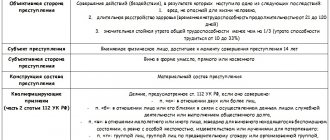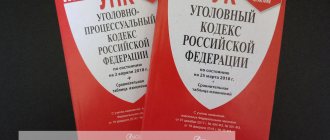ST 112 of the Criminal Code of the Russian Federation.
1. Intentional infliction of moderate harm to health, not dangerous to human life and not entailing the consequences specified in Article 111 of this Code, but causing long-term health disorder or significant permanent loss of general working capacity of less than one third, is punishable by restriction of freedom for a term of up to three years, or forced labor for a term of up to three years, or arrest for a term of up to six months, or imprisonment for a term of up to three years.
2. The same act committed: a) in relation to two or more persons; b) in relation to a person or his relatives in connection with the performance of official activities by this person or the performance of public duty; c) in relation to a minor or another person who is known to be in a helpless state by the perpetrator, as well as with special cruelty, humiliation or torture for the victim; d) by a group of persons, a group of persons by prior conspiracy or an organized group; e) for hooligan reasons; f) for reasons of political, ideological, racial, national or religious hatred or enmity, or for reasons of hatred or enmity towards any social group; g) has lost its force; h) with the use of weapons or objects used as weapons - is punishable by imprisonment for a term of up to five years.
Characteristics of moderate harm
One of the defining criteria for harm to health of moderate severity is a long-term illness (i.e., transient loss of working capacity for more than three weeks (21 days) or extensive loss of cumulative working capacity of less than one third (this defining criterion of loss of cumulative working capacity is assigned according to the testimony of forensic experts).The final characteristic of causing harm to health of moderate severity is the loss of total ability to work from 10% to 30%, which is determined with the help of forensic experts.
What qualifies as moderate beating?
Moderate severity is characterized by:
- complete incapacitation of the victim for a short period of time;
- or persistent but minor health impairment;
- loss of working capacity of less than one third;
- no danger to life.
Visible health problems of the person who received the blows may include the following types of injuries, confirmed during examination by a forensic expert:
- concussions;
- fractures of the nose or jaws;
- limb fractures;
- rib fractures, if internal organs are not affected;
- extensive hematomas on the surface of the skin;
- joint dislocations;
- bites, cuts and other damage to the surface of the skin.
When qualifying this crime, the absence of a threat to the life of the victim, as well as the reversibility of the health consequences, are taken into account. Internal organs should not be affected here; all violations should involve complete rehabilitation of the victim. For intentionally inflicted cuts, burns, etc. in the facial area, the liability is aggravated in comparison with injury to closed areas of the body.
If damage of moderate severity was caused in a public place, read this material.
Violence of a husband towards his wife has its own characteristics. We talked about where and how to film a husband beating him and what the punishment would be for beating his wife. Check them out if this is your situation.
The corpus delicti under Article 112 of the Criminal Code of the Russian Federation
This offense is qualified by the intentionality of its causes and can be undertaken with both indirect and direct intent. The causer of harm initially knew the unsafety of his active or passive behavior for society, foresaw the inevitability or likelihood of dangerous consequences for people around him and wanted them to occur (reflected in the second part of the article, which establishes crimes committed intentionally). A crime is considered committed with indirect intent if the one who committed it initially understood the unsafety of his behavior (inactivity) for society, foresaw the inevitability or likelihood of dangerous results for people around him, did not want, but deliberately foresaw the consequences or was indifferent to them. The defining characteristics identified in the second part of the article on murder are included in the special elements of the crime.
Corpus delicti
We list the important features of the crime:
- The object is public relations that ensure the safety of the health of citizens.
- The objective side is expressed in the unlawful infliction of moderate harm to the health of another person through action or inaction with criminal consequences.
- A causal relationship must be established between the act and the consequence.
- The subject may be an individual who has reached 14 years of age at the time of the crime.
- The subjective side is characterized by intentional guilt. Intention can be direct or indirect. Most often, the intent here is vague (unspecified).
Please note that causing moderate harm to health differs from attempted murder and attempt to cause grievous harm to health (Article 105 and Article 111 of the Criminal Code of the Russian Federation).
The corpus delicti and the intent of the perpetrator are essential.
Attempt means the impossibility of completing one’s intention due to circumstances beyond the control of the attacker (intervention of third parties, active resistance of the victim, provision of medical care to the victim, etc.). Often the attempt is associated with serious harm to health.
Collection and liability
From the age of 14, any person can be criminally punished for an offense under Part 1 of Art. 112 of the Criminal Code of the Russian Federation. Causing harm to health of moderate gravity is punishable by restriction of liberty for a term of up to three years, or forced labor for a term of up to three years, or arrest for a term of up to six months, or imprisonment for a term of up to three years. The crime is of medium gravity, therefore, for committing it, a real prison sentence is only possible for a person who has already had a criminal record or has committed this offense while on parole. For example, A. and B., unknown to him, drank alcohol in the park. They quarreled, and A., approaching the victim, hit him on the head with his hand a number of times, as a result of which B. fell. A. again approached him and began to inflict numerous injuries a second time. As a result, B. fell unconscious, and A. fled the crime scene. Based on the findings of forensic experts, the victim was found to have such characteristics as a concussion, bruises on the head in the area of hair growth, and soft tissue bruises in the neck area. In total, these traits are defined as causing damage to health of moderate severity on the basis of a long-term health disorder. Part 2 Art. 112 of the Criminal Code of the Russian Federation
| Part 2 Art. 112 of the Criminal Code of the Russian Federation - causing harm to health of moderate severity: |
| in relation to two or more persons; |
| in relation to a person or his relatives in connection with the performance of official activities by this person or the performance of public duty; |
| in relation to a minor or another person who is known to be in a helpless state by the perpetrator, as well as with special cruelty, humiliation or torture for the victim; |
| a group of persons, a group of persons by prior conspiracy or an organized group; |
| for hooligan reasons; |
| for reasons of political, ideological, racial, national or religious hatred or enmity, or for reasons of hatred or enmity towards any social group; |
| using weapons or objects used as weapons |
The punishment for the second part is up to 5 years in prison.
Criminally punishable acts committed out of hooligan motives should be understood as deliberate actions directed against a person’s person or his property, which were committed without any reason or using an insignificant reason. At the same time, in order to correctly establish these motives in the event that the perpetrator commits violent acts during a quarrel or fight, the courts need to find out who initiated them, and whether the conflict was provoked to use it as a reason to commit illegal actions. If the instigator of a quarrel or fight is the victim, as well as in the case where the conflict was caused by his illegal behavior, the person is not liable for committing a crime against such victim out of hooligan motives.
Under what article will this offense be committed?
In this case, liability arises according to the provisions of Article 112 of the Criminal Code of the Russian Federation. It is of a criminal nature and is determined on the basis of part 1, with a lack of qualifications, and part 2 – with the presence of qualifications.
The qualification includes aggravating circumstances accompanying the beating, which may consist of the following:
- battery of several persons;
- group beating;
- hooligan urges;
- use of weapons;
- beatings inflicted out of racial, religious, political hatred;
- causing intentional injury to a child or teenager.
When determining the norms of an article, differences in actions and consequences from other articles are taken into account.
In particular, they must differ from the norms of Articles 1.1.6 of the Code of Administrative Offenses of the Russian Federation, 116 and 115 of the Criminal Code of the Russian Federation. That is, the degree of consequences should be determined as more significant. Sometimes difficulties arise in determining the responsibility of the guilty party, which are based on the following criteria:
- absence in the inspection report of all the consequences that occurred. These circumstances may arise mainly due to late contact with the authorized body, when it is no longer possible to restore the full picture.
- Direct fault of the person who received harm to health in the form of provocation. In this case, the actions of the accused cannot be considered intentional.
- If in a street or domestic fight both participants were equally injured.
REFERENCE: A medical examination report can also be drawn up on the basis of an extract from the medical history obtained at the medical institution where the victim underwent a course of rehabilitation therapy.
The main difficulty in applying liability measures to the perpetrator is the lack of a statement from the victim. This type of application of punishment belongs to the category of private charges, when a criminal case is initiated not on the basis of a precedent of beating, but on the basis of a claim by the victim.
Statement of private prosecution
Minimum types of liability under Art. 112 of the Criminal Code of the Russian Federation: what will happen to the culprit?
This crime can be considered in accordance with the provisions of Part 1 of Article 112 of the Criminal Code of the Russian Federation, which provides for the following punishment for the attacker:
- arrest up to 6 months;
- forced labor – up to three years;
- restriction of movement - up to three years.
This article does not provide for administrative punishment. It is also impossible to limit yourself to paying a fine; such punishment is not imposed. The conditions for suppressing a crime are much stricter than for beatings with the least consequences for the victim.
In order to reduce the preventive measure, the guilty person will need to fully repent of the crime committed, including providing all possible assistance in restoring the health of the victim.
In what case will the liability be administrative (according to the Code of Administrative Offenses of the Russian Federation) and when will only a fine be imposed as a punishment?
Preliminary investigation and consideration of criminal cases of this category.
The initiation of criminal cases for offenses described in the first part of the article of the criminal code under consideration occurs by the bodies of inquiry (inquirers) and is considered by magistrates. The second part of the article is much more seriously initiated by the investigation, and consideration takes place in district courts.
Do I need to call the police?
According to life safety conditions, in order to minimize the risk of death, a police patrol must be called at the first opportunity. The sooner the police arrive when there is a security threat, the less damage to health will be caused.
The arriving police will be able to prevent the beating instantly. And the victim will be given first aid and an ambulance with a qualified team of specialists will be called. Subsequently, the investigation of the crime will be carried out by the police, and if necessary, the offender will be arrested. If the police squad was not called, and the victim of the beating turned for help to a medical institution or trauma center, the doctors of the medical institution submit a report of beatings to the police , based on the victim’s request. It also provides for an investigative procedure, followed by transfer of the case to court.
When applying to the court on your own, you must provide the personal information of the perpetrator. You should contact the district court at the place of residence of the perpetrator or at the place of the incident.
Be sure to read the article about what removing beatings is and how to remove them correctly(!). It is also important to know:
- When should this be done?
- What evidence other than a medical report can be used? Details here.
- And what to do if you remove the beatings a few days after they were inflicted.
Exemption from criminal liability
If the conflict is resolved with the victim, it is likely that he will be released from criminal liability. This principle is enshrined in the general part of the criminal code in an article containing provisions on reconciliation with a person who has suffered harm. However, we should not forget that termination of a criminal case through reconciliation of the parties is the right of the court, and not its obligation. The court must examine from all sides the type and degree of threat to society when making a decision, also examine the information and identity of the defendant and other materials of the case (whether the victim was recognized as a victim, his financial well-being, whether the victim was influenced to resolve the conflict, what was done the culprit to reduce the damage caused during the offense, etc.). When making a final verdict, it is necessary to understand whether it contradicts the goals and objectives of protecting the powers and legal interests of an individual, society and the state.
Can they be deprived of their freedom?
In case of beatings of moderate severity, the norms of criminal law are always applied. Punishment in the form of imprisonment in this case is used quite often. It can follow even in accordance with the norms of part 1 of the indicated article. In this case, it reaches three years in prison.
If you have qualifications, liability arises according to the norms of Part 2 of the Criminal Code of the Russian Federation. Here the term of imprisonment can reach 5 years. The severity of the punishment in this case is rightfully determined by the cruelty of the person, who is of a dangerous nature to members of society.
IMPORTANT: Criminal liability for this crime begins at the age of 14 years.
In order to avoid antisocial behavior, the court provides for his isolation from society for a proportionate period.



